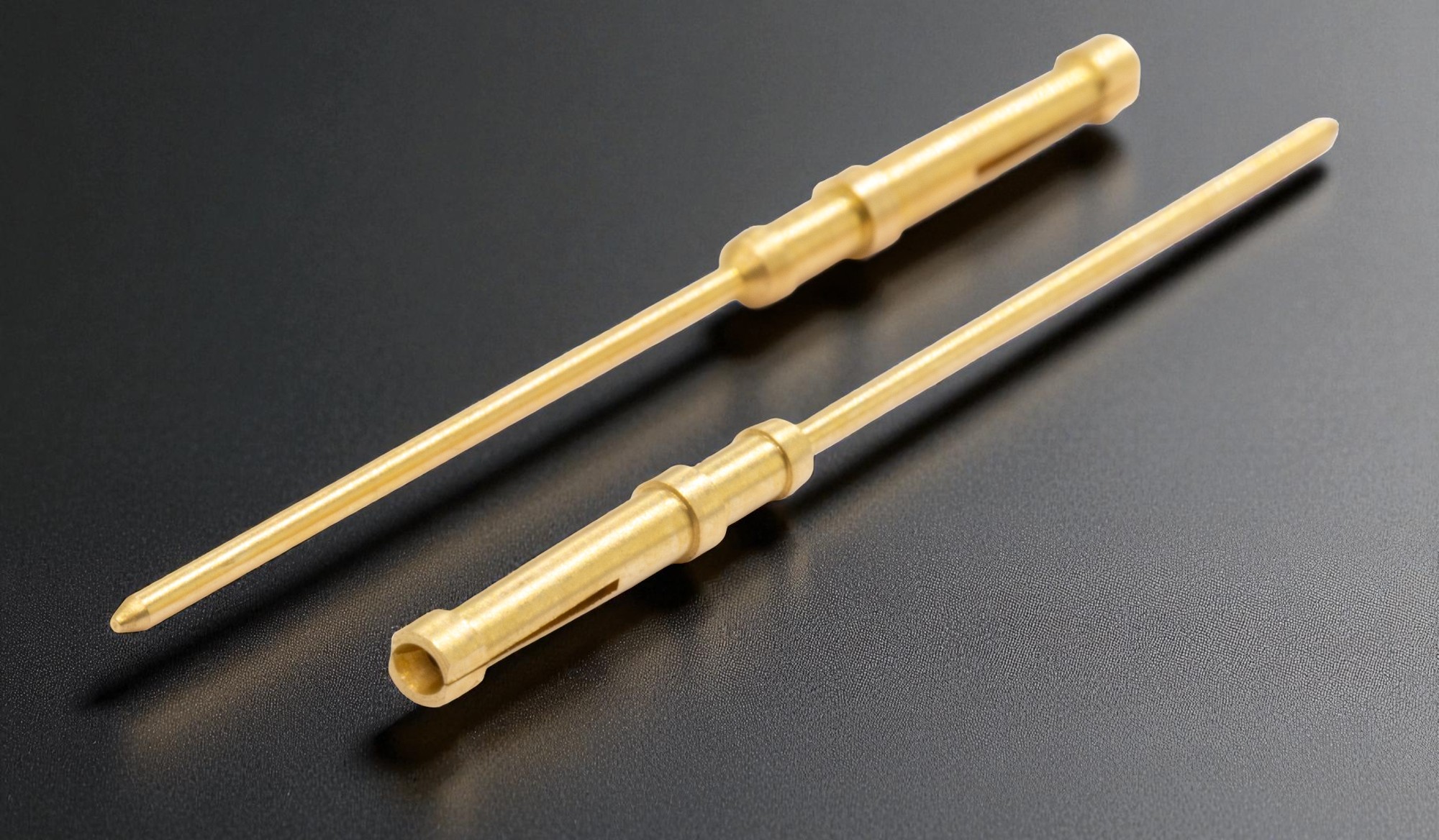By Franky Nguyen, AVF Decolletage
Introduction
In every electrical connector, performance begins and ends with contact resistance — the microscopic resistance that forms where a pin meets its socket.
Even though this resistance is measured in milliohms, it can have massive consequences. Slight variations can cause signal loss, overheating, or premature connector failure. That’s why precision machining, plating, and testing are essential in modern connector pin manufacturing.
At AVF Decolletage, we engineer every pin and socket to achieve stable, ultra-low contact resistance — ensuring electrical efficiency and reliability across millions of mating cycles.
See our connector manufacturing capabilities
What Is Contact Resistance?
Contact resistance refers to the electrical resistance between two mating conductive surfaces — typically where a connector pin touches the socket.
While the base metal may be highly conductive, microscopic imperfections, oxide films, and surface roughness can disrupt current flow. The goal of precision manufacturing is to make that resistance as low and consistent as possible.
Factors That Influence Contact Resistance
The true challenge in connector design is controlling the small variables that add up to big differences in resistance.
1. Surface Finish and Cleanliness
Rough, oxidized, or contaminated surfaces restrict the number of true contact points.
AVF Decolletage uses burr-free Swiss machining and automated polishing to achieve mirror-smooth finishes that maximize contact area and minimize micro-arcing.
⚙️ 2. Plating and Surface Coating
Plating determines how well the pin resists oxidation and maintains conductivity:
| Plating Type | Performance Characteristics |
|---|---|
| Gold | Ultra-low resistance, excellent corrosion protection, ideal for high-frequency connectors. |
| Nickel | Durable, oxidation-resistant, slightly higher resistance but robust for harsh environments. |
| Tin | Cost-effective, good solderability, but requires controlled storage to avoid oxidation. |
We work with qualified plating suppliers in Singapore and the USA to ensure consistent coating adhesion and uniform thickness across production batches.
View our approved materials and finishes

3. Pin Geometry and Contact Design
Connector pin shape affects both current flow and contact stability.
-
Conical or domed tips concentrate contact pressure and reduce micro-gaps.
-
Flat or slotted designs distribute current evenly, improving thermal balance.
AVF Decolletage engineers each geometry to balance mechanical fit, electrical flow, and wear resistance.
4. Environmental Factors
Heat, vibration, humidity, and oxidation can gradually increase resistance.
That’s why harsh-environment connectors rely on protective plating and dimensional consistency — ensuring performance stability under extreme temperature or vibration.
Why Low Contact Resistance Matters
Electrical performance and mechanical longevity depend on keeping resistance low and stable:
-
⚡ Signal Integrity: Low resistance maintains clean, distortion-free data transmission.
-
Energy Efficiency: Reduces power losses and voltage drop across the connection.
-
Thermal Management: Prevents hotspots that can melt insulation or degrade plating.
-
Reliability: Ensures consistent performance over repeated mating and vibration cycles.
Even a small increase in resistance — from 2 mΩ to 5 mΩ — can generate heat buildup that leads to long-term connector degradation.
How AVF Decolletage Controls Contact Resistance
At AVF Decolletage, precision is engineered into every stage of production:
1. Swiss CNC & CAM Machining
We machine every connector pin to ±0.005 mm tolerance, ensuring perfect concentricity and burr-free surfaces.
2. Automated Deburring & Surface Polishing
Our finishing processes eliminate microscopic irregularities that could disrupt contact paths.
3. Controlled Plating & Adhesion Testing
All plating work is handled by certified suppliers and verified with XRF measurement for thickness and uniformity.
4. Contact Resistance Validation
Pins undergo continuity testing, four-point probe resistance checks, and thermal cycling validation to ensure stability over time.
5. ISO 9001:2015 Quality System
All processes — from machining to plating verification — follow our certified quality system for repeatable results.
Learn more about our quality control
The Role of Design Collaboration
We don’t just manufacture — we collaborate.
Our engineers work directly with OEM teams to optimize pin geometry, plating, and surface finish for each application. Whether it’s high-frequency telecom, aerospace sensors, or medical instruments, every design is tailored to minimize resistance and maximize reliability.
Conclusion
In the world of precision connectors, contact resistance is the hidden benchmark of quality.
By combining Swiss CNC precision, premium materials, and ISO-certified inspection, AVF Decolletage delivers connector pins that maintain ultra-low resistance — even after millions of cycles in the harshest conditions.
When reliability and conductivity matter most, trust AVF Decolletage to keep your systems connected without interruption.
Frequently Asked Questions (FAQ)
Q1: What is an acceptable contact resistance level for connector pins?
Typically in the low milliohm range, depending on application — gold-plated contacts offer the best stability.
Q2: How does plating influence resistance?
Gold ensures the lowest and most consistent resistance, while nickel and tin provide durability and cost efficiency.
Q3: Can surface finish affect performance?
Absolutely. Smooth, burr-free finishes reduce micro-arcing and maintain stable current flow.
Q4: Which industries are most sensitive to contact resistance?
Aerospace, telecom, medical, and automotive electronics require precise, stable conductivity.
Q5: How does AVF Decolletage verify low contact resistance?
Through surface analysis, XRF plating verification, and micro-ohm contact resistance testing.


